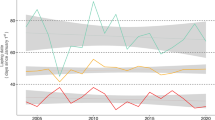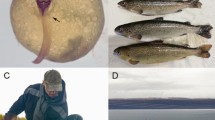Abstract
Maternal effects are typically thought to enhance rather than reduce offspring performance, but asynchronous hatching (ASH) in birds typically produces a size hierarchy within a clutch that frequently reduces the growth and survival of nestlings from eggs that hatch later. Given that yolk steroids can significantly affect offspring phenotype and that in many species the levels of yolk steroids have been found to increase with laying order, the maternal transfer of steroids to egg yolk has been proposed as a mechanism for females to offset the deleterious effects of ASH. To test this hypothesis, we determined whether yolk steroids varied with laying order or clutch size in Common Grackles (Quiscalus quiscula). Because ASH varies with clutch size (hatching span averages 48 h in five-egg clutches, 24 h in four-egg clutches) and regularly results in the starvation of later hatched nestlings, we predicted: (1) testosterone and 17ß-estradiol levels should increase with laying order in both clutch sizes to mitigate the negative effects of ASH on last-hatched nestlings, and (2) the increase should be greater in five-egg clutches due to more pronounced hatching asynchrony. Using a competitive-binding steroid radioimmunoassay, we found no systematic variation in either testosterone or estradiol levels relative to laying order or clutch size. In the absence of evidence that yolk steroids interact adaptively with ASH, research must look elsewhere for potential benefits that might compensate for the costs these steroids impose on nestlings.




Similar content being viewed by others
References
Adkins-Regan E, Ottinger MA, Park J (1995) Maternal transfer of estradiol to egg yolks alters sexual differentiation of avian offspring. J Exp Zool 271:466–470. doi:https://doi.org/10.1002/jez.1402710608
Bowden RM, Ewert MA, Nelson CE (2000) Environmental sex determination in a reptile varies seasonally and with yolk hormones. Proc R Soc Lond B 267:1745–1749. doi:https://doi.org/10.1098/rspb.2000.120
Clark AB, Wilson DS (1981) Avian breeding adaptations: hatching asynchrony, brood reduction, and nest failure. Q Rev Biol 56:253–277
Crawley MJ (1993) GLIM for ecologists. Blackwell Scientific Publishing, Oxford
Eising CM, Groothuis TGG (2003) Yolk androgens and begging behaviour in black-headed gull chicks: an experimental field study. Anim Behav 66:1027–1034. doi:https://doi.org/10.1006/anbe.2003.2287
Eising CM, Eikenaar C, Schwbl H, Groothuis TGG (2001) Maternal androgens in black-headed gull (Larus ridibundus) eggs: consequences for chick development. Proc R Soc Lond B 268:839–846. doi:https://doi.org/10.1098/rspb.2001.1594I
Elf PK, Fivizzani AJ (2002) Changes in sex steroid levels in yolks of the leghorn chicken, Gallus domesticus, during embryonic development. J Exp Zool 293:594–600. doi:https://doi.org/10.1002/jez.10169
Ellis LA, Borst DW, Thompson CF (2001) Hatching asynchrony and maternal androgens in egg yolks of house wrens. J Avian Biol 32:26–30. doi:https://doi.org/10.1034/j.1600-048X.2001.320104.x
Gil D (2003) Golden eggs: Maternal manipulation of offspring phenotype by egg androgen in birds. Ardeola 50:281–294
Gil D, Graves J, Hazon N, Wells A (1999) Male attractiveness and differential testosterone investment in zebra finch eggs. Science 286:126–128. doi:https://doi.org/10.1126/science.286.5437.126
Groothuis TGG, Muller W, von Engelhardt N, Carere C, Eising C (2005) Maternal hormones as a tool to adjust offspring phenotype in avian species. Neurosci Biobehav Rev 29:329–352. doi:https://doi.org/10.1016/j.neubiorev.2004.12.002
Harper RG, Juliano SA, Thompson CF (1992) Hatching asynchrony in the house wren, Troglodytes aedon: a test of the brood-reduction hypothesis. Behav Ecol 3:76–83
Harper RG, Juliano SA, Thompson CF (1994) Intrapopulation variation in hatching synchrony in house wrens: test of the individual-optimization hypothesis. Auk 111:516–524
Howe HF (1976) Egg size, hatching asynchrony, sex, and brood reduction in the common grackle. Ecology 57:1195–1207
Howe HF (1978) Initial investment, clutch size, and brood reduction in the common grackle (Quiscalus quiscula L.). Ecology 59:1109–1122
Krackow S, Tkadlec E (2001) Analysis of brood sex ratios: implications of offspring clustering. Behav Ecol Sociobiol 50:293–301. doi:https://doi.org/10.1007/s002650100366
Lipar JL (2001) Yolk steroids and the development of the hatching muscle in nestling European starlings. J Avian Biol 32:231–238. doi:https://doi.org/10.1111/j.0908-8857.2001.320305.x
Lipar JL, Ketterson ED (2000) Maternally derived yolk testosterone enhances the development of the hatching muscle in the red-winged blackbird Agelaius phoeniceus. Proc R Soc Lond B 267:2005–2010. doi:https://doi.org/10.1098/rspb.2000.1242
Lipar JL, Ketterson ED, Nolan V (1999) Intraclutch variation in testosterone content of red-winged blackbird eggs. Auk 116:231–235
Maddox JD, Weatherhead PJ (2008) Egg size variation in birds with asynchronous hatching: is bigger really better? Am Nat 171:358–365. doi:https://doi.org/10.1086/527500
Magrath RD (1990) Hatching asynchrony in altricial birds. Biol Rev 65:587–622
Marshall DJ, Uller T (2007) When is a maternal effect adaptive? Oikos 116:1957–1963
Mazuc J, Chastel O, Sorci G (2003) No evidence for differential maternal allocation to offspring in the house sparrow (Passer domesticus). Behav Ecol 14:340–346
Müller W, Eising CM, Dijkstra C, Groothuis TGG (2004) Within-clutch patterns of yolk testosterone vary with the onset of incubation in black-headed gulls. Behav Ecol 15:893–897. doi:https://doi.org/10.1093/beheco/arh091
Peer BD, Bollinger EK (1997) Common grackle (Quiscalus quiscula). No. 271. In: Poole, A, Gill, F (eds) The birds of North America. Academy of Natural Sciences/American Ornithologists’ Union, Philadelphia/Washington D.C. doi: bna.271
R Development Core Team (2008) R: A language and environment for statistical computing. R Foundation for Statistical Computing, Vienna, Austria. ISBN 3-900051-07-0. URL: http://www.R-project.org
Reed WL, Vleck CM (2001) Functional significance of variation in egg-yolk androgens in the American coot. Oecologia 128:164–171. doi:https://doi.org/10.1007/s004420100642
Schwabl H (1993) Yolk is a source of maternal testosterone for developing birds. Proc Natl Acad Sci USA 90:11446–11450. doi:https://doi.org/10.1073/pnas.90.24.11446
Schwabl H (1996) Maternal testosterone in the avian egg enhances postnatal growth. Comp Biochem Physiol 114:271–276. doi:https://doi.org/10.1016/0300-9629(96)00009-6
Schwabl H, Mock DW, Gieg JA (1997) A hormonal mechanism for parental favoritism. Nature 386:231
Slagsvold T, Sandvik J, Rofstad G, Lorentsen O, Husby M (1984) On the adaptive value of intraclutch egg-size variation in birds. Auk 101:685–697
Sockman KW, Schwabl H (2000) Yolk androgens reduce offspring survival. Proc R Soc Lond B 267:1451–1456. doi:https://doi.org/10.1098/rspb.2000.1163
Sockman KW, Sharp PJ, Schwabl H (2006) Orchestration of avian reproductive effort: an integration of the ultimate and proximate bases for flexibility in clutch size, incubation behavior, and yolk androgen deposition. Biol Rev 81:629–666. doi:https://doi.org/10.1017/S1464793106007147
Stoleson SH, Beissinger SR (1995) Hatching asynchrony and the onset of incubation in birds, revisited: when is the critical period? Curr Ornithol 12:191–270
Venables WN, Ripley BD (2002) Modern applied statistics with S. Springer, New York
von Engelhardt N, Dijkstra C, Daan S, Groothuis TGG (2004) Effects of 17-ß-estradiol treatment of female zebra finches on offspring sex ratio and survival. Horm Behav 45:306–313. doi:https://doi.org/10.1016/J.Yhbeh.2003.12.009
Williams TD (1999) Parental and first generation effects of exogenous 17 ß-estradiol on reproductive performance of female zebra finches (Taeniopygia guttata). Horm Behav 35:135–143. doi:https://doi.org/10.1006/hbeh.1998.1506
Williams TD, Kitaysky AS, Vezina F (2004) Individual variation in plasma estradiol-17ß and androgen levels during egg formation in the European starling Sturnus vulgaris: implications for regulation of yolk steroids. Gen Comp Endocrinol 136:346–352. doi:https://doi.org/10.1016/J.Ygcen.2004.01.010
Williams TD, Ames CE, Kiparissis Y, Wynne-Edwards KE (2005) Laying-sequence-specific variation in yolk oestrogen levels, and relationship to plasma oestrogen in female zebra finches (Taeniopygia guttata). Proc R Soc Lond B 272:173–177. doi:https://doi.org/10.1098/Rspb.2004.2935
Wingfield JC, Farner DS (1975) The determination of five steroids in avian plasma by radioimmunoassay and competitive protein-binding. Steroids 26:311–327
Winkler DW (1993) Testosterone in egg yolks: an ornithologist’s perspective. Proc Natl Acad Sci USA 90:11439–11441. doi:https://doi.org/10.1073/pnas.90.24.11439
Acknowledgments
We thank Tim O’Connor for help in the field, Patti Wesley for help preparing yolk samples, Becky Fuller for laboratory use for preparing yolk samples, Kevin Dyer and Justin Lamb for allowing us access to their tree farm, and the University of Illinois and the American Ornithologists’ Union for funding. This research was carried out under the approval of the Institutional Animal Care and Use Committee of the University of Illinois at Urbana–Champaign (#05006).
Author information
Authors and Affiliations
Corresponding author
Additional information
Communicated by C.G. Guglielmo.
Rights and permissions
About this article
Cite this article
Maddox, J.D., Bowden, R.M. & Weatherhead, P.J. Yolk testosterone and estradiol variation relative to clutch size, laying order and hatching asynchrony in Common Grackles. J Ornithol 149, 643–649 (2008). https://doi.org/10.1007/s10336-008-0311-0
Received:
Revised:
Accepted:
Published:
Issue Date:
DOI: https://doi.org/10.1007/s10336-008-0311-0




